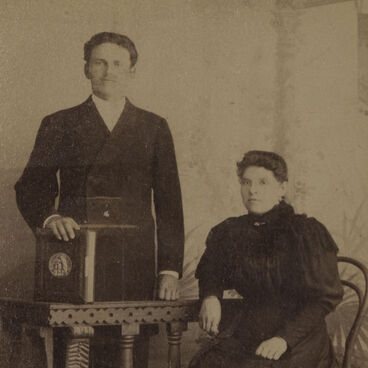This folding fan with an image of a young Japanese woman is made of veneer, very thin slices of wood. The accessory consists of separate sticks connected by a ribbon at the top and held together by a pin at the handle. It was produced in the mid-20th century. Hand fans were not particularly popular among the Cossacks. However, this accessory was often used by actors on stage. It was also an important attribute in the audience. It was used both to create an airflow and to indicate the owner’s status.
The first theaters were founded in the Don region in the first half of the 19th century. Initially, theatrical performances took place in outdoor public spaces. They were presented by touring playing companies and music bands from Moscow, Kiev, Kharkov, and other cities of the Russian Empire.
In 1825, the appointed ataman Aleksey Ilovaysky started inviting actors from other cities to Novocherkassk and later opened his own small theater. After some time, a theater company was founded in Taganrog, and theaters were opened in Rostov-on-Don and other large cities of the Don Region.
The acting profession attracted people from various social classes, including noblemen, the bourgeoisie, free peasants, and serfs. Amateurs also participated in theater productions. Popular actors joined Don theater companies to earn money. Theaters were financed partly by municipal and military budgets, and partly by the profits from performances.
Don theaters produced vaudevilles of various levels of sophistication, mediocre plays aimed at the lowbrow taste of merchants and government officials, humorous sketches, and other lighthearted performances. However, there were also high-quality productions based on the classical plays of famous Russian and foreign authors, including Griboyedov, Gogol, Fonvizin, Schiller, Shakespeare, and others.
Despite the initial lack of artistic merits, theaters enjoyed success with the audience: boxes were booked by wealthy families several weeks ahead, and ticket sales produced significant profits.
Over time, the level of theatrical ensembles improved, and the nation’s interest in art increased. In the 1920s and 1930s, the “Ideal” cinema of the Karginskaya stanitsa housed a drama club. A local schoolteacher produced various performances, plays, and vaudevilles. Each new performance was an event of cultural significance for the residents of the stanitsa and nearby hamlets alike. The young Mikhail Sholokhov played an active part in the work of this drama club as an actor, the author of plays and comedy sketches.
The first theaters were founded in the Don region in the first half of the 19th century. Initially, theatrical performances took place in outdoor public spaces. They were presented by touring playing companies and music bands from Moscow, Kiev, Kharkov, and other cities of the Russian Empire.
In 1825, the appointed ataman Aleksey Ilovaysky started inviting actors from other cities to Novocherkassk and later opened his own small theater. After some time, a theater company was founded in Taganrog, and theaters were opened in Rostov-on-Don and other large cities of the Don Region.
The acting profession attracted people from various social classes, including noblemen, the bourgeoisie, free peasants, and serfs. Amateurs also participated in theater productions. Popular actors joined Don theater companies to earn money. Theaters were financed partly by municipal and military budgets, and partly by the profits from performances.
Don theaters produced vaudevilles of various levels of sophistication, mediocre plays aimed at the lowbrow taste of merchants and government officials, humorous sketches, and other lighthearted performances. However, there were also high-quality productions based on the classical plays of famous Russian and foreign authors, including Griboyedov, Gogol, Fonvizin, Schiller, Shakespeare, and others.
Despite the initial lack of artistic merits, theaters enjoyed success with the audience: boxes were booked by wealthy families several weeks ahead, and ticket sales produced significant profits.
Over time, the level of theatrical ensembles improved, and the nation’s interest in art increased. In the 1920s and 1930s, the “Ideal” cinema of the Karginskaya stanitsa housed a drama club. A local schoolteacher produced various performances, plays, and vaudevilles. Each new performance was an event of cultural significance for the residents of the stanitsa and nearby hamlets alike. The young Mikhail Sholokhov played an active part in the work of this drama club as an actor, the author of plays and comedy sketches.



